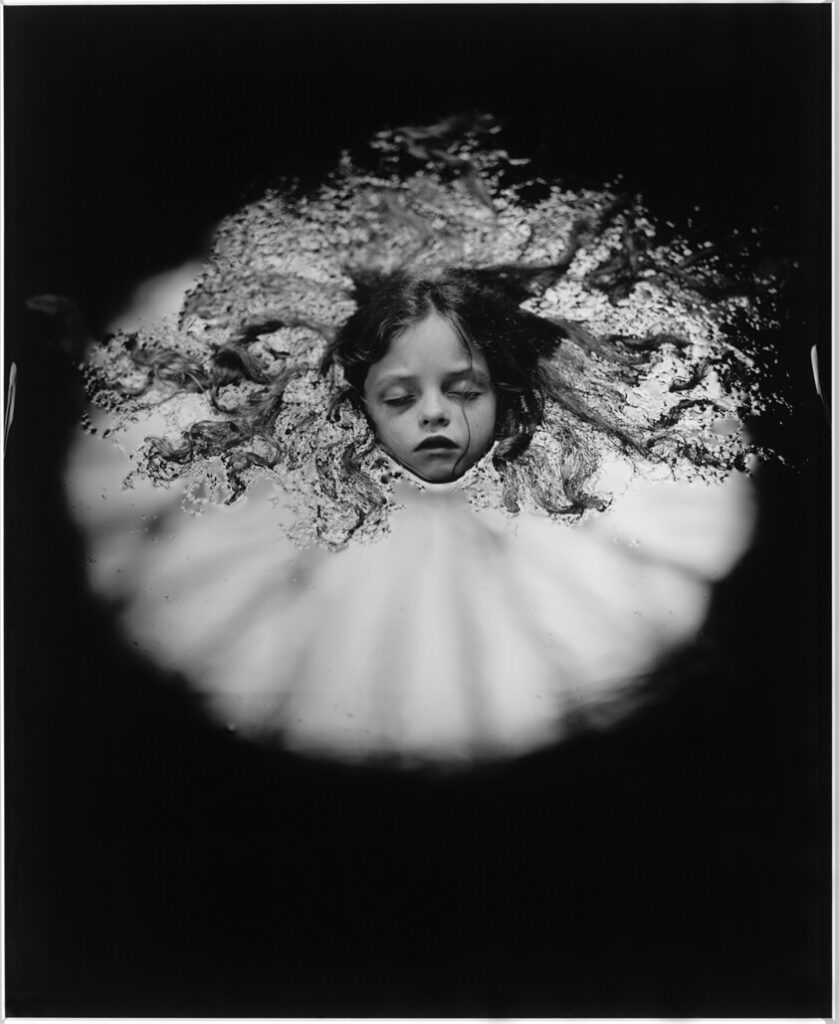
Sally Mann was born on May 1, 1951 in Lexington, Virginia. She attended Hollins College and graduated in 1947 with a Bachelor of Arts. She married Larry Mann in 1970 and has three children Jessie, Virginia, and Emmett. She is a photographer and writer who published many books. Her work is usually in black and white capturing people and landscape.
“At Warm Springs” by Sally Mann is a photo in one of her exhibitions called “Immediate Family”. It is about her family and the subjects are usually her three children, Virginia, Jessie, and Emmett. In the photo above, the subject is her daughter, Virginia. Her body is submerged underwater, only her head and hair is visible drifting in pitch-black darkness.
As I was searching for Sally Mann photos in google images this photo captivated me, it appears to be a head just floating in space. The photo got me intrigued, wondering what this was supposed to be about. As it piqued my curiosity, I clicked on the photo to enlarge it and saw details I could not see before. Her body engulfs in darkness only her expressionless but peaceful face is displayed along with her twisted hair. At first, I could not distinguish what the background is, I assumed she was buried in sand, but as I did my research I found out she is submerged in water. Looking closely, I can slightly see the ripples in the water near her hair and towards the back.
At the first glimpse, I thought death and mortality is the theme that Mann is trying to portray because the subject reminds me of a corpse, her emotionless but peaceful face, closed eyes, and buried. However, upon doing further research I realized I was completely wrong. The theme in the series is about her children’s childhood, freedom, and memories of everyday life. As mentioned before, I thought the photo was about death so I would say what I can relate to in the photo is my own expiration and the unavoidable loss of those close to me as morbid as that sounds, but now after doing research I can relate to the memories of my childhood in the pool with my family, the happier and peaceful time.
Sally Mann uses symmetry and high contrast of light and dark creating a dramatic composition. The darkness completely engulfs her body. Only the direct light illuminates her face and it also resembles a spotlight framing her and that holds my attention. As I try to look around at the dark background, the lines continue to lead my eyes toward the subject further emphasizing her importance. The use of symmetry makes the photo neat, and deliberate. It also looks dynamic because the subject is not straight in the center, but more towards the top. Furthermore, the texture of the ripples in the water creates an outline of her hair which make the photography intriguing.
I choose this photographer because I admire her work. As you know I prefer black and white, dramatic composition with high contrast, and the interplay with light and shadow. Many of my photographs do not have a human subject, I focus more on buildings and objects which is why I admire her portraits of people. I love how she is able to capture their expressions and movement. Her photos are also thought-provoking and compel you to click on her photos to view them more clearly.
Works cited:
Artnet.com, http://www.artnet.com/artists/sally-mann/biography.
Bellafante, Ginia. “Sally Mann Portrait in Which She’s the Star.” The New York Times, The New York Times, 31 Jan. 2007, https://www.nytimes.com/2007/01/31/arts/television/31sall.html.
Editorial, Artsy, and Matt Williams. “Sally Mann’s ‘Immediate Family’ Challenged My Understanding of Photography.” Artsy, 7 Jan. 2020, https://www.artsy.net/article/artsy-editorial-artwork-changed-life-sally-manns-immediate-family.
Mann, Sally. “Sally Mann’s Exposure.” The New York Times, The New York Times, 16 Apr. 2015, https://www.nytimes.com/2015/04/19/magazine/the-cost-of-sally-manns-exposure.html.
“Why Was Sally Mann’s Immediate Family so Controversial?” Public Delivery, https://publicdelivery.org/tag/sally-mann/.





Recent Comments